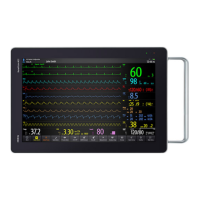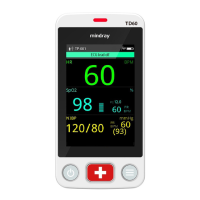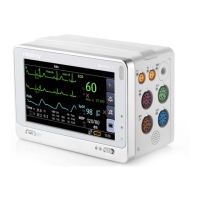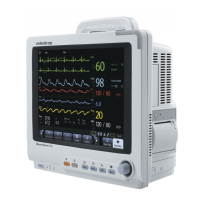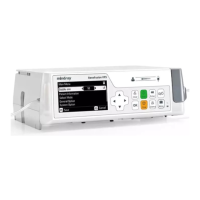3-12 BeneVision N17/BeneVision N15/BeneVision N12 Patient Monitor Service Manual
If necessary, you can print out the square wave and wave scale through the recorder and then measure
the difference.
3.3.2 Resp Performance Test
Tools required:
Medsim300B patient simulator or other equivalent simulator
1. Connect the patient simulator to the module using a non ESU-proof cable and set lead II as the
respiration lead.
2. Configure the simulator as follows: lead II as the respiration lead, base impedance line as 500 Ω; delta
impedance as 1 Ω, respiration rate as 20 rpm.
3. Verify that the Resp wave is displayed without any distortion and the displayed Resp value is within
20±1 rpm.
3.3.3 SpO
2
Test
Tools required:
None.
1. Connect SpO2 sensor to the SpO2 connector of the monitor. Set Patient Category to Adult and PR
Source to SpO2 on the monitor.
2. Apply the SpO
2
sensor to the ring finger of a healthy person.
3. Check the Pleth wave and PR reading on the screen and make sure that the displayed SpO
2
is within
95% and100%.
4. Remove the SpO
2
sensor from your finger and make sure that an alarm of SpO
2
Sensor Off is
triggered.
Measurement accuracy verification:
The SpO
2
accuracy of the MPM module has been verified in human experiments by comparing with
arterial blood sample reference measured with a CO-oximeter. Pulse oximeter measurements are
statistically distributed and about two-thirds of the measurements are expected to come within the
specified accuracy range compared to CO-oximeter measurements.
NOTE
A simulator cannot be used to assess the accuracy of a pulse oximeter monitor or a SpO
2
sensor. Instead, it can only verify that whether the monitor is functional. The accuracy of a
pulse oximeter monitor or a SpO
2
sensor needs to be verified by clinical data.

